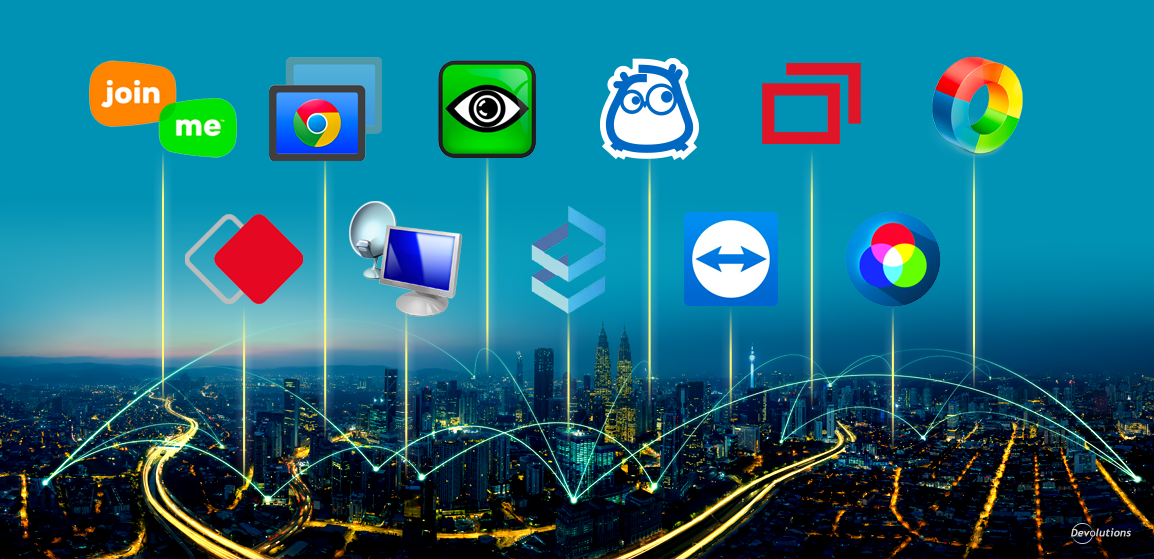Features
When comparing TeamViewer vs AnyDesk, the Slant community recommends TeamViewer for most people. After a while your MAC address gets banned and the free version will stop working. Each time the application is in the process of being closed it.

LogMeIn allows users to access and manage computers remotely. The company offers many different products with different features, but only paid versions are available for personal use. Various LogMeIn products enable users to sync clipboard data, make use of keyboard mapping, and save and manage passwords. Other features include multi-monitor support, HD video quality screen-sharing, remote-to-local printing, desktop sharing, file sharing, cloud syncing and backup, remote sound, drag and drop file transfer, and background login.
TeamViewer's remote access can be used for a wide variety of collaborative and supportive services, ranging from file sharing, online meetings, and recorded conferences, to troubleshooting a computer or network and granting or removing access from off-site devices. Depending on the level of access, everything from administrative functions to single-file access can be managed from the dashboard. TeamViewer is free for non-commercial use and adds a layer of security by using automatic logouts when any session ends.
Demos
A demo featuring TeamViewer:
A 2-minute demo on how to use LogMeIn:
Products and Editions
TeamViewer offers a number of different remote access products:
- TeamViewer All-in-One allows users to establish connections as well as wait for incoming connections. As the name indicates, it is TeamViewer's full suite of services for team and group collaboration.
- TeamViewer QuickSupport does not need to be installed to run, making it ideal for users who want to connect quickly for support services.
- TeamViewer Host allows for 24/7 access to remote computers, including the ability to log in and out and reboot remotely. It is designed for server maintenance and home office access.
- TeamViewer QuickJoin enables customers to participate in online presentations without any need of complicated set-ups.
- TeamViewer Manager is designed so that administrators can log in from anywhere and diagnose, monitor, and report on the functionality of connections.
- TeamViewer Portable is a streamlined application that can run from a USB stick or a CD, allowing for portability and simplified access to TeamViewer's service options.
Similarly, LogMeIn offers a wide range of remote access tools:
Better Than Teamviewer For Mac Free
- LogMeIn Pro is the most basic version of LogMeIn, allowing users to remotely access their files for management.
Teamviewer
- LogMeIn Rescue enables users to remotely support PCs, Macs, and smartphones without any pre-installed software.
Anydesk For Mac
- LogMeIn Central is a web-based management console that supports remote support sessions.
Restrictions
LogMeIn allows multiple users to connect to a single host, but only one user can control that session/connection.
TeamViewer only allows one connection (channel) at a time with the free version, or three with the 'Corporate' version of their software. While only one connection can be made in the free version, screen-sharing for meetings and presentations can be done with up to 15 'participants' (i.e., users can watch the session content, not be connect with the computers themselves).
Better Than Teamviewer For Mac Download
Mobile Apps
LogMeIn has mobile apps for iOS and Android. The iOS app is free, and allows remote control, remote app access, HD quality images, file management, cloud integration, email attachments, and photo management. The Android version is also free and allows for remote access, remote app access, and remote sound. Both apps require one to have a trial or paid version of LogMeIn to work.
TeamViewer offers apps for Android, Windows 8, and Blackberry. These are all free to download and use personally, and allow mobile access to an office desktop or other computer. Users can also remotely administer unattended computers, such as servers.
Price
LogMeIn for Individuals costs $99 a year and allows access to 2 computers from the web, a computer, or mobile devices running on the iOS or Android operating systems. A 'Power User' subscription rate is $249 a year, allowing access to up to 5 computers, and the 'Small Business' rate is $449 a year for remote access of up to 10 computers.
TeamViewer is free for all noncommercial users, but limits free remote access to a one-to-one experience (i.e., only one device can connect to one other device). To be able to connect to more computers and/or devices, a user must consider a commercial license:
- Business: $749 for one licensed workstation and meetings of up to 15 participants; most service options included. Additional licensed workstations are $139 each.
- Premium: $1,499 for unlimited workstations, up to 25 participants in a meeting, and nearly every service option provided.
- Corporate: $2,839 for unlimited workstations, up to 25 participants in a meeting, and every TeamViewer service option provided. Also, up to 3 sessions can run simultaneously, with additional channels costing $989 each.
TeamViewer licenses are one-time fees that include free version upgrades (from 10.1 to 10.2, for example). Major version releases (e.g., from 9 to 10) have an optional upgrade fee.
Security Features
LogMeIn uses 256-bit SSL end-to-end encryption for all connections . [1] The user logs in using an email address and password, and can select additional verification steps, such as one-time-use codes from a pre-printed sheet, or from emails. When logging in from a new remote location, users can authenticate either using a personal password of an RSA SecurID two-factor authenticator.
TeamViewer secures connections using 2048-bit RSA key exchange and 256-bit AES session encoding.[2]
Risks
Users should be careful when allowing someone else remote access of their computer through LogMeIn or TeamViewer, as that individual can access any files as though they were sitting at the computer themselves.
Popularity
LogMeIn is used by both individual PC users and large companies, including BestBuy, HSBC, and Rolls-Royce.
TeamViewer is used by more than 100,000,000 across the world, including by companies such as Dell, Philips, Intel, Microsoft, IBM, and UPS.
References
You may not know what a remote desktop tool is. To put it simple, a remote desktop tool is a software that can be used to connect to device such as a computer or a mobile phone remotely and through the internet connection. Such software are a great tool to perform tasks on a specific device when it is not possible to have physical access to it. You can also use these software to troubleshoot or fix issues with a particular device or use them to share files between your own and the target device. Now, there are a number of such apps in the market. The most popular one is definitely TeamViewer which is in fact very comprehensive. But since this application has been having limitations in some countries, you might be looking for an alternative. Another remote desktop tool which is also widely popular is AnyDesk. But is it a better option than TeamViewer? Read this AnyDesk vs TeamViewer comparison to find out more.
TeamViewer
Many believe that TeamViewer is by far the best remote access tool available in the market. TeamViewer software is a remote access software which is exceptionally well-designed and it is produced by keeping security measures in mind. TeamViewer is absolutely user-friendly and easy to use. It also offers a portable version which makes it faster and easier to use. Here are some of the features you can have with TeamViewer:
- It offers free trial as well as the premium version
- Compatible with a great variety of devices
- Works with multiple monitors
- Multi-level security for transferred files
- It supports text, video and voice chats during the session
TeamViewer is definitely a great remote access tool. You can download TemViewer from the below link.
Now we will see how TeamViewer would differ in a AnyDesk vs TeamViewer comparison.
AnyDesk
If you are looking for a great tool for remote device monitoring and you don’t want to use TeamViewer, AnyDesk is of course a great option. What is significant about AnyDesk is its high speed and this is the main reason why many people prefer to download AnyDesk to other apps. AnyDesk is known to be the fastest remote access software in the global market. Many believe that in an AnyDesk vs TeamViewer comparison for speed, Anydesk would probably be the winner. Another reason why AnyDesk is a great option for remote access purposes is the fact that it encrypts all the data to account for the privacy of the shared files. Let’s take a look at AnyDesk features.
- 60 frame per second transfer rate
- Small file size
- Secured connections protected with TLS1.2 encryption
- Minimum delay in carrying commands between the two devices
- Compatible with major platforms
Undoubtedly, AnyDesk is a great remote access software. You can download AnyDesk from the below link.
Now it is time for a full AnyDesk vs TeamViewer comparison. let’s see how these two great tools differ in terms of the service that they offer to their users.

AnyDesk vs TeamViewer
Remote desktop access programs are a great tool for mutual work and technical support. But you may wonder which one is a better option to use. Here is a full AnyDesk vs TeamViewer comparison to help you choose.
As for the device compatibility, it can be said that TeamViewer is indeed the winner. TeamViewer is compatible with mobile device as well as desktop computers. You can use TeamViewer on Windows, Linux, MAC, iOS, and Android. However, AnyDesk does not offer iOS or Android clients for mobile devices.
Another disadvantage of AnyDesk in AnyDesk vs TeamViewer comparison is that if the target doesn’t run the client as administrator, you can’t access system features that require UAC elevation. Also, AnyDesk uses more CPU power than TeamViewer.
The conclusion is that for remote desktop access purposes, TeamViewer is indeed a better option. But if you cannot use it for any reason, AnyDesk is by far the best substitute for TeamViewer.